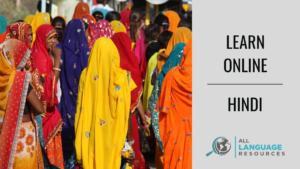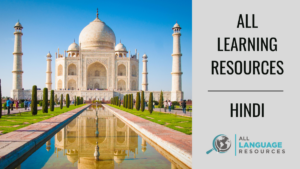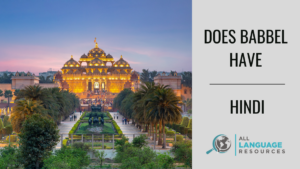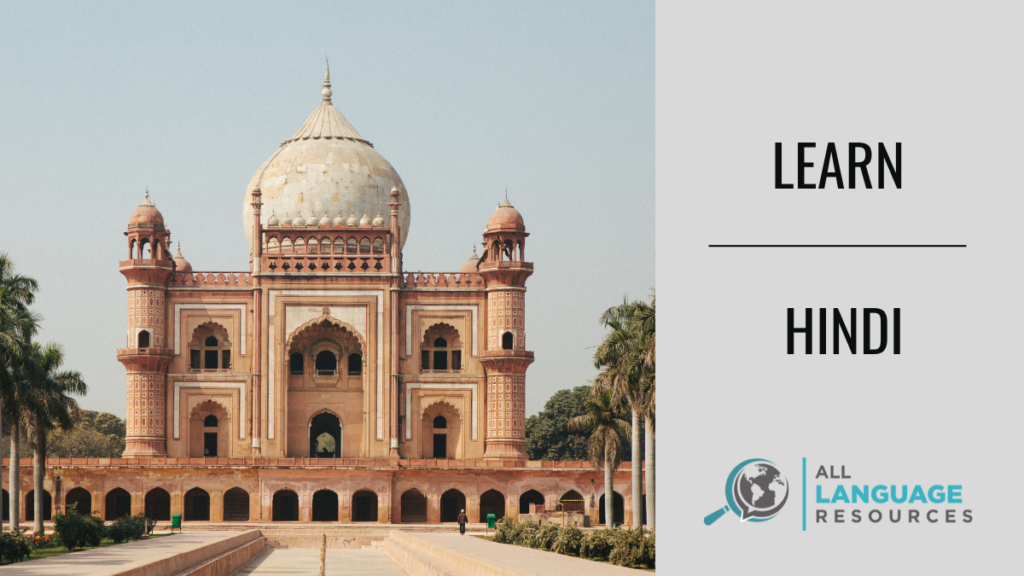In a world rich with diverse cultures and languages, few languages capture the essence of tradition, modernity, and vibrancy quite like Hindi. Spoken by millions across India and increasingly recognized on the global stage, Hindi is not just a language; it’s a gateway to a world of art, culture, and rich heritage. Whether you’re drawn to the captivating melodies of Bollywood music, the intricate flavors of Indian cuisine, or the warm hospitality of its people, learning Hindi opens doors to a plethora of experiences and opportunities.
If you already know how to learn Hindi and want to go straight to reading our recommendations and Hindi resource reviews, you may want to check these posts out:





 The Language Exchange Showdown: Our Top Apps & Websites
The Language Exchange Showdown: Our Top Apps & Websites
In this beginner’s guide, we embark on a journey to unravel the beauty and complexity of Hindi. From its rich history to its practical applications in today’s interconnected world, we delve into the fundamentals of the language, equipping you with the tools and knowledge needed to navigate conversations, express yourself, and immerse in the cultural tapestry of Hindi-speaking communities.
Join us as we embark on this linguistic adventure, where each lesson brings us closer to unlocking the secrets of Hindi and discovering the boundless possibilities that come with embracing a new language. Whether you’re a traveler eager to explore India’s bustling streets, a language enthusiast seeking new horizons, or simply someone enchanted by the allure of Hindi, this guide is your passport to a world of linguistic and cultural discovery.
Learn Hindi online on your own with these tips, strategies, and recommendations. How to Learn Hindi? Where to Learn Hindi? Hindi Script? Find out here. Let’s dive in, as we embark on a journey to learn Hindi – a language that not only connects us to millions of speakers worldwide but also opens doors to a world of endless fascination and wonder.
Table of Contents
Loanwords to English
Do you wear pajamas to bed? Then you use a Hindi word regularly. The word for English word for nightwear comes from the Hindi word pajama which was imported from the Persian words for ‘leg clothes.’
Perhaps you know someone who has a cushy job? To a Hindi speaker, you’re describing their job as being ‘pleasant’ or ‘nice’ as English borrowed ‘cushy’ from khush.
If your grandparents live in a bungalow with a veranda, then they have a whole home system set up with Hindi words.
Thanks in a large part to British colonialism in India, a lot of Hindi words have been borrowed into everyday English, so your Hindi vocabulary is already larger than you think!
Hindi Language: A History
The history of the Hindi language is deeply intertwined with the cultural, social, and linguistic evolution of the Indian subcontinent. Hindi, along with its close relative Urdu, belongs to the Indo-Aryan branch of the Indo-European language family and has a rich and diverse history spanning over several millennia.
The roots of Hindi can be traced back to the ancient Indo-Aryan languages spoken by migrants who entered the Indian subcontinent around 1500 BCE. These languages evolved over time, influenced by contact with other linguistic groups in the region.
Sanskrit, the ancient liturgical language of Hinduism and classical Indian culture, exerted a significant influence on the development of Hindi. Many words and grammatical structures in Hindi are derived from Sanskrit.
During the medieval period, Hindi underwent further evolution due to interactions with Persian and Arabic, primarily through the Muslim conquests of North India. This led to the development of a new literary form known as “Hindavi,” which later evolved into Hindi and Urdu.
The Bhakti movement, which flourished between the 14th and 17th centuries, played a crucial role in shaping Hindi literature and language. Bhakti poets composed devotional songs and verses in vernacular languages, including Hindi, making religious texts accessible to the masses.
The arrival of European colonizers, particularly the British, had a profound impact on Hindi. English loanwords entered the language, and Hindi began to develop a distinct literary tradition under the patronage of British-educated elites.
In the 19th and 20th centuries, efforts were made to standardize Hindi and promote it as a national language of India. The Nagari script, derived from the ancient Brahmi script, was adopted as the official script for Hindi, leading to greater uniformity in written communication.
After India gained independence in 1947, Hindi was declared one of the official languages of the country. The Indian government has since played a proactive role in promoting Hindi as a means of national integration while also respecting the linguistic diversity of the country.

Taj Mahal, India. Photos from Britannica.com
Loanwords in Hindi
Hindi, like many languages, has borrowed words from various languages over its long history of development and interaction. Some of the major languages from which Hindi has borrowed words include:
Sanskrit: As Hindi is descended from Sanskrit, it naturally shares a significant vocabulary with its ancient ancestors. Many technical, scientific, and philosophical terms in Hindi are derived directly from Sanskrit.
धर्म (dharma) – meaning “duty” or “religion.”
विद्या (vidyā) – meaning “knowledge” or “education.”
मनुष्य (manuṣya) – meaning “human” or “man.”
Persian/Arabic: During the medieval period, Persian and Arabic words entered Hindi through cultural and trade interactions, as well as through the influence of Islamic rule in North India. These borrowings include terms related to administration, literature, religion, and everyday life.
इंतज़ार (intezār) – meaning “wait” or “anticipation” (from Persian).
ज़िंदगी (zindagī) – meaning “life” (from Persian).
ख़ुशबू (ḵẖušbū) – meaning “fragrance” or “scent” (from Persian).
Turkish: With the advent of Turkish invasions and subsequent rule in parts of North India, Hindi absorbed a number of Turkish loanwords, particularly in areas related to governance, military, and administration.
सिपाही (sipāhī) – meaning “soldier” or “constable.”
जमींदार (jamīndār) – meaning “landlord” or “landowner.”
चायवाला (chāyvālā) – meaning “tea seller” or “tea vendor.”
English: In more recent times, especially during the British colonial period and its aftermath, English loanwords have become increasingly prevalent in Hindi, particularly in fields such as technology, education, administration, and popular culture.
टेलीविज़न (ṭelivizan) – meaning “television.”
कॉलेज (kolej) – meaning “college.”
इंटरनेट (inṭarnet) – meaning “internet.”
Portuguese: Some Portuguese words made their way into Hindi during the colonial period, especially in coastal regions where Portuguese traders and missionaries had significant influence. These borrowings are relatively limited but still present in certain domains.
अल्मीरा (almīrā) – meaning “wardrobe” or “cupboard.”
बालचीनी (bālcīnī) – meaning “cinnamon.”
ज़िन्दगी (zindagī) – meaning “life” (originally from the Portuguese “viver”).
Indigenous Indian Languages: Hindi has also borrowed words from various indigenous languages of India, particularly those spoken in the regions where Hindi is prevalent. These borrowings include terms related to local flora, fauna, food, cultural practices, and social customs.
आम (ām) – meaning “mango” (borrowed from Sanskrit via Marathi).
सार्सों (sārsō) – meaning “mustard” (borrowed from Sanskrit via Punjabi).
पगड़ी (pagṛī) – meaning “turban” (borrowed from Marathi or Punjabi).
How to Learn Hindi: Hacking Hindi for English Speakers
Where to Learn Hindi – Find online resources
There are so many online resources available for helping to learn Hindi and it can be hard to know where to start. Luckily, we have already put together some guides to help you get started:
Best apps: https://www.alllanguageresources.com/best-apps-for-learning-hindi/
Best courses: https://www.alllanguageresources.com/hindi-courses/
Best podcasts: https://www.alllanguageresources.com/hindi-podcasts/
We also recommend this course from Hindustani Tongue, which describes itself as “a language learning platform that focuses on teaching Indian languages in such a way that people from every age group can learn effectively and can speak the language from the very first day.”
Embrace the Hindi Script
One of the first challenges English speakers encounter when learning Hindi is mastering the Devanagari script. While it may seem daunting at first, embracing the script is crucial for developing fluency in reading and writing Hindi.
The Devanagari script has its roots in the Brahmi script, one of the oldest writing systems in the Indian subcontinent. It evolved from the Gupta script during the 7th century CE and became standardized by the 14th century. Over time, Devanagari emerged as the primary script for Sanskrit and several modern Indian languages.
The Devanagari script consists of 47 primary characters, including vowels and consonants. Each character represents a specific sound, and the script is written from left to right. Vowels are typically written as independent characters, while consonants are often combined with vowel symbols to form syllables.
One distinctive feature of Devanagari is the use of conjunct consonants, where two or more consonants are combined to form a single character (such as ksh). This feature allows for the representation of complex consonant clusters commonly found in Hindi and other Indian languages.
In addition to letters, Devanagari script also includes a set of numerals used for writing numbers. These numerals are distinct from Arabic numerals and have their own unique symbols.
Learn to Speak Hindi by Practicing Regularly
Like any skill, speaking Hindi requires regular practice to improve fluency and confidence. Find language exchange partners or join language meetup groups to practice speaking with native speakers.
Don’t be afraid to make mistakes; embracing imperfection is an essential part of the learning process. Use everyday situations, such as ordering food or shopping, as opportunities to practice speaking Hindi in real-life scenarios.
As we have seen, Hindi has a phonetic alphabet, meaning that each letter represents a specific sound, with relatively consistent pronunciation rules. This makes it easier for learners to read and pronounce Hindi words once they understand the sounds associated with each letter.
Hindi has 11 vowels, which can be short or long. Short vowels are pronounced briefly, while long vowels are held for a longer duration. The vowels are:
– Short: अ (a), आ (ā), इ (i), ई (ī), उ (u), ऊ (ū), ए (e), ऐ (ai), ओ (o), औ (au)
– Long: आ (ā), ई (ī), ऊ (ū), ए (ē), ओ (ō), औ (au)
Hindi has 33 consonants, each with its own unique pronunciation. Some consonants have aspirated and unaspirated versions, which affect their pronunciation. For example, the unaspirated “p” is pronounced like the English “p” in “spin,” while the aspirated “ph” is pronounced with a puff of air, similar to the English “p” in “pit.”
Hindi includes nasalized sounds, indicated by a dot or bindu (ं) called “anusvara” or “nukta,” which nasalizes the preceding vowel or consonant. For example, the word मंगल (mangal) has a nasalized “ng” sound.
In Hindi, stress typically falls on the first syllable of a word. However, stress patterns may vary in certain words or due to regional accents.
Focus on High-Frequency Hindi Words
When building your vocabulary, prioritize high-frequency words that are commonly used in everyday conversation. Start with basic greetings, expressions, and common phrases, then gradually expand your vocabulary to include more advanced words and concepts. Language learning apps like Anki or Quizlet can help you create flashcards and quizzes to reinforce vocabulary retention.
High-frequency words in Hindi are those words that appear frequently in everyday conversation, writing, and communication. These words form the backbone of the language and are essential for understanding and expressing oneself effectively.
Some of the highest-frequency words in Hindi include:
1. और (aur) – and
2. क्या (kyā) – what
3. है (hai) – is/am/are
4. मैं (main) – I/me
5. तुम (tum) – you (informal)
6. हूँ (hūn) – am/is/are (for first person singular)
7. हैं (haiṅ) – are (for third person plural)
8. नहीं (nahīṅ) – no/not
9. को (ko) – to/for
10. कर (kar) – do/make
11. यह (yah) – this
12. वह (vah) – that
13. हम (ham) – we/us
14. उनका (unkā) – their
15. उन्हें (unheṅ) – them
16. से (se) – from/by
17. पर (par) – on/at
18. कहाँ (kahāṅ) – where
19. कैसे (kaise) – how
20. कब (kab) – when
These words are fundamental building blocks of Hindi language proficiency and are encountered frequently in everyday communication. Mastering these high-frequency words is essential for beginners as they provide a strong foundation for further language learning and fluency development.

Zanskar Valley, Leh-Ladakh in Northern India. Photo by – incredibleindia.org
Get to grips with grammatical gender
Yes, Hindi does have grammatical gender, although it operates differently from gender systems found in some other languages like French or German.
In Hindi, nouns are classified into two grammatical genders: masculine (पुल्लिंग) and feminine (स्त्रीलिंग).
Masculine Gender (पुल्लिंग)
Nouns that denote male beings or objects are typically classified as masculine. For example:
– लड़का (laṛkā) – boy (masculine)
– पेड़ (peṛ) – tree (masculine)
Feminine Gender (स्त्रीलिंग)
Nouns that denote female beings or objects are classified as feminine. For example:
– लड़की (laṛkī) – girl (feminine)
– मछली (machlī) – fish (feminine)
– गाड़ी (gāṛī) – car (feminine)
Noun Agreement
Adjectives, pronouns, and verbs in Hindi agree with the gender of the noun they modify or refer to.
For example:
– मेरा लड़का (merā laṛkā) – my son (masculine)
– मेरी लड़की (merī laṛkī) – my daughter (feminine)
– वह पुस्तक पढ़ रहा है। (vah pustak paṛh rahā hai) – He is reading a book. (masculine)
– वह पुस्तक पढ़ रही है। (vah pustak paṛh rahī hai) – She is reading a book. (feminine)
Exceptions
While many nouns in Hindi have obvious gender distinctions, some nouns do not follow conventional gender patterns. These nouns may have fixed grammatical gender regardless of the biological gender (or lack thereof) of the object they represent.
– सूरज (sūraj) – sun (masculine)
– चाँद (chāṇd) – moon (masculine)
– मिट्टी (miṭṭī) – soil/earth (feminine)
Understanding grammatical gender is essential for proper agreement and communication in Hindi. While it may seem complex to learners accustomed to languages without gender systems, such as English, practice and exposure to the language help in mastering this aspect of Hindi grammar.
Watch Bollywood movies
Bollywood is the informal term used to refer to the Hindi-language film industry based in Mumbai, India.
Renowned for its vibrant storytelling, colorful musical numbers, and star-studded productions, Bollywood is one of the largest and most influential film industries in the world.
The term “Bollywood” is a portmanteau of “Bombay” (the former name of Mumbai) and “Hollywood,” symbolizing the industry’s connection to the city of Mumbai and its inspiration from the American film industry.
Bollywood produces a vast array of films, including romance, comedy, drama, action, and musicals, catering to diverse audiences both within India and across the globe. With its rich cultural tapestry, larger-than-life narratives, and iconic song-and-dance sequences, Bollywood continues to captivate audiences and shape popular culture on a global scale.
There is a huge range of Bollywood films, each of which has garnered widespread popularity and acclaim, making them notable within the Indian film industry. Some of the most popular contemporary films include:
1. “Shershaah”: Released in 2021, “Shershaah” is a biographical war drama film based on the life of Captain Vikram Batra, an Indian Army officer who was posthumously awarded the Param Vir Chakra, India’s highest wartime gallantry award. The film stars Sidharth Malhotra and Kiara Advani in lead roles and received positive reviews for its performances and portrayal of real-life events.
2. “Ludo”: Directed by Anurag Basu, “Ludo” is a dark comedy anthology film released in 2020. The film features an ensemble cast including Abhishek Bachchan, Rajkummar Rao, Pankaj Tripathi, and others. “Ludo” received praise for its unique storytelling style, strong performances, and engaging narrative.
3. “Sooryavanshi”: Directed by Rohit Shetty, “Sooryavanshi” is an action film released in 2021 as part of Shetty’s cop universe, which includes the “Singham” and “Simmba” franchises. Starring Akshay Kumar and Katrina Kaif in lead roles, the film follows an Anti-Terrorism Squad (ATS) officer as he battles terrorism in Mumbai. “Sooryavanshi” was highly anticipated and performed well at the box office.
4. “Radhe: Your Most Wanted Bhai”: A 2021 action film directed by Prabhu Deva and starring Salman Khan, “Radhe: Your Most Wanted Bhai” is a remake of the South Korean film “The Outlaws.” The film received mixed reviews from critics but attracted significant attention due to Khan’s star power and action sequences.
5. “Sardar Udham”: Released in 2021, “Sardar Udham” is a biographical drama film directed by Shoojit Sircar and starring Vicky Kaushal in the titular role of Udham Singh, a revolutionary freedom fighter. The film explores Singh’s journey and his quest for justice following the Jallianwala Bagh massacre. “Sardar Udham” received critical acclaim for its performances, direction, and historical accuracy.
Watch Indian soap operas
Indian soap operas, often referred to as “saas-bahu sagas” (mother-in-law and daughter-in-law dramas), are a prominent genre within Indian television programming.
Indian soap operas primarily focus on family dramas, with storylines centered around familial relationships, marriages, and generational conflicts. Themes such as love, betrayal, jealousy, and redemption are common, and the narrative often explores the complexities of familial bonds.
Many Indian soap operas are female-centric and revolve around the lives of women, particularly the central female protagonists who navigate various challenges and obstacles within the family and society. These characters often embody traditional values of sacrifice, resilience, and familial duty. With the prominence of women in Indian society in mind, soap operas frequently address social issues and taboos prevalent in Indian society, including dowry, domestic violence, gender inequality, and superstitions. While some serials aim to raise awareness and promote social change, others may reinforce existing stereotypes and norms.
Five very popular soap operas include:
Kyunki Saas Bhi Kabhi Bahu Thi: This iconic soap opera, which aired from 2000 to 2008, was produced by Ekta Kapoor’s Balaji Telefilms and is considered one of the pioneers of the “saas-bahu saga” genre. The show revolved around the lives of the Virani family and their matriarch, Tulsi Virani, played by Smriti Irani. It enjoyed immense popularity and became one of the longest-running Indian television series.
Kahaani Ghar Ghar Kii: Another immensely popular serial produced by Balaji Telefilms, “Kahaani Ghar Ghar Kii” aired from 2000 to 2008. The show depicted the trials and tribulations of the Agarwal family and their interconnected relationships. Sakshi Tanwar portrayed the central character of Parvati Agarwal, earning widespread acclaim for her performance.
Kumkum Bhagya: This long-running soap opera premiered in 2014 and continues to enjoy high viewership. Produced by Ekta Kapoor, the show follows the love story of Abhi and Pragya, played by Shabir Ahluwalia and Sriti Jha, respectively. “Kumkum Bhagya” has garnered a loyal fan base and is known for its melodramatic plot twists and romantic storyline.
Yeh Rishta Kya Kehlata Hai: Airing since 2009, “Yeh Rishta Kya Kehlata Hai” is one of the longest-running Indian television serials. Produced by Rajan Shahi, the show explores the lives of the Goenka and Singhania families, focusing on the marital relationship between the protagonists, Naira and Kartik, played by Shivangi Joshi and Mohsin Khan.
Taarak Mehta Ka Ooltah Chashmah: While not a traditional saas-bahu saga, “Taarak Mehta Ka Ooltah Chashmah” is a hugely popular sitcom that has been entertaining audiences since 2008. Based on the column “Duniya Ne Undha Chashma” by journalist Taarak Mehta, the show depicts the humorous interactions and daily adventures of residents living in the Gokuldham Co-operative Housing Society.
Listen to Hindi language music
Hindi language music encompasses a diverse range of musical genres and styles, reflecting the rich cultural heritage and artistic expressions of India. From traditional folk music to contemporary film songs and independent music, Hindi music holds a prominent place in Indian culture and entertainment.
Bollywood Music: Bollywood music, often characterized by its catchy melodies, vibrant rhythms, and lyrical storytelling, is perhaps the most recognizable genre of Hindi music. These songs are featured in Indian films, where they serve as integral components of storytelling and emotional expression. Bollywood music encompasses various styles, including romantic ballads, dance numbers, qawwalis, and folk-inspired tracks.
2. Film Songs: Hindi film songs, commonly referred to as “filmi gaane,” are composed by music directors and sung by playback singers for inclusion in movies. These songs play a crucial role in enhancing the narrative, conveying emotions, and establishing the mood of a film. Iconic playback singers such as Lata Mangeshkar, Mohammed Rafi, Asha Bhosle, Kishore Kumar, and others have left an indelible mark on Hindi film music with their timeless contributions.
3. Independent Music: In recent years, independent music in Hindi has gained prominence, with artists exploring diverse musical styles and themes outside the realm of Bollywood. Independent musicians and bands create original compositions and release them through various platforms, including streaming services, YouTube, and social media. This has provided a platform for experimentation, creativity, and artistic expression in Hindi music.
4. Folk Music: India’s diverse cultural landscape is reflected in its rich tradition of folk music, which varies widely from region to region. Hindi folk music encompasses a myriad of styles, including Bhojpuri, Rajasthani, Punjabi, and Garhwali, among others. These traditional songs often celebrate local festivals, rituals, and customs, and are passed down through generations via oral traditions.
5. Devotional Music: Bhajans, kirtans, and qawwalis are forms of devotional music that hold spiritual significance in Hindi culture. These songs are dedicated to various deities and saints and are performed in temples, shrines, and religious gatherings across India. Devotional music serves as a means of worship, meditation, and spiritual upliftment for millions of devotees.
6. Pop and Rock Music: While not as prevalent as Bollywood or folk music, Hindi pop and rock music have carved out a niche for themselves in the Indian music scene. Bands and solo artists experiment with Western influences, blending elements of pop, rock, and Indian classical music to create unique sounds and styles.
Some of the most popular singers include:
1. Arijit Singh: Renowned for his soulful voice and versatility, Arijit Singh is one of the most prominent playback singers in the Hindi music industry. With numerous chart-topping hits to his name, Singh has captured the hearts of audiences with his emotive renditions of romantic ballads and peppy tracks. His collaborations with leading music composers and producers have contributed to his immense popularity.
2. Atif Aslam: Pakistani singer-songwriter Atif Aslam has carved a niche for himself in the Hindi music industry with his powerful vocals and heartfelt performances. Known for his chart-topping singles such as “Tera Hone Laga Hoon” and “Tere Bin,” Aslam has amassed a dedicated fan following across India and beyond.
3. Neha Kakkar: With her energetic stage presence and catchy songs, Neha Kakkar has emerged as one of the top female playback singers in Bollywood. From peppy dance numbers to soulful melodies, Kakkar’s versatile voice has made her a favorite among audiences of all ages. She has delivered numerous hits and has also gained popularity as a judge on reality singing competitions.
4. Badshah: Rapper and music producer Badshah has made a significant impact on the Indian music scene with his catchy beats and witty lyrics. Known for his chart-topping singles such as “DJ Waley Babu,” “Mercy,” and “Paagal,” Badshah has played a pivotal role in popularizing hip-hop and rap music in mainstream Bollywood.
5. A.R. Rahman: A.R. Rahman, often referred to as the “Mozart of Madras,” is a legendary composer, singer, and music producer who has left an indelible mark on the Hindi music industry. With his groundbreaking work in films such as “Roja,” “Dil Se,” and “Slumdog Millionaire,” Rahman has won numerous accolades, including Academy Awards and Grammy Awards, for his contributions to music.
6. Shreya Ghoshal: Shreya Ghoshal is one of the most celebrated playback singers in Bollywood, known for her melodious voice and impeccable vocal range. With numerous hit songs to her credit, Ghoshal has won several awards for her contributions to the Hindi music industry and continues to enthrall audiences with her soul-stirring performances.
Conclusion
In conclusion, embarking on the journey to learn Hindi opens up a world of rich cultural heritage, vibrant linguistic expression, and countless opportunities for connection and understanding. Whether you’re drawn to the beauty of Hindi literature, the excitement of Bollywood cinema, or the warmth of Indian hospitality, learning Hindi offers a gateway to experiencing the diverse tapestry of Indian culture firsthand. While mastering a new language requires dedication, patience, and practice, the rewards are immeasurable. As you immerse yourself in the study of Hindi, embrace the joys of discovery, celebrate your progress, and cherish the moments of connection with native speakers and fellow learners alike. With determination and enthusiasm, you’ll find yourself unlocking the door to a world of endless possibilities and enriching experiences. So, seize the opportunity to learn Hindi, and embark on a journey of language and cultural exploration that will leave a lasting impact on your life. शुभ यात्रा! (Shubh yatra! – Happy journey!)

